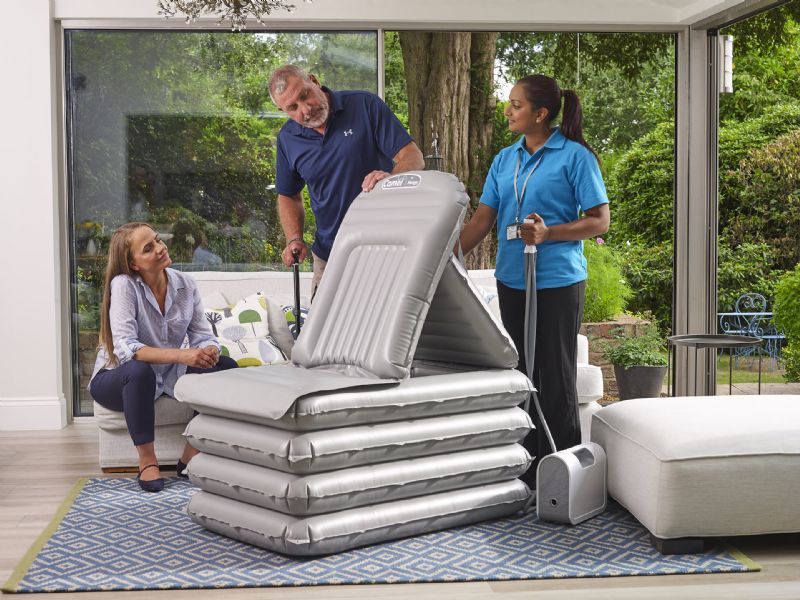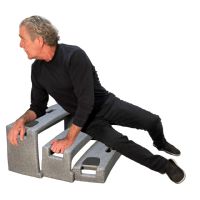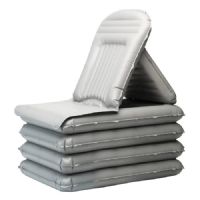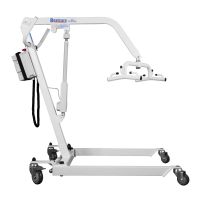 Written by Heather Collins, MSN, RN, CNOR
Written by Heather Collins, MSN, RN, CNOR
Falls are a significant health risk, often leading to a wide range of injuries that can be mild to severe. Unfortunately, falls are prevalent, and they can have life-changing consequences. Every year, over 684,000 fatal falls occur worldwide, raising the question of whether all falls can be prevented. With a growing aging population, falls have become a pressing issue for healthcare professionals, caregivers, and individuals. According to the Centers for Disease Control and Prevention (CDC), one in four Americans aged 65 and older experiences a fall each year, making falls the primary cause of both fatal and non-fatal injuries within this demographic. It's crucial to take proactive steps to prevent falls and be prepared to help our loved ones recover should they experience a fall.
To address the matter of fall prevention, it is essential to recognize that a combination of intrinsic and extrinsic factors influence falls. Intrinsic factors encompass age, health conditions, and strength, while extrinsic factors relate to the environment, such as lighting conditions, clutter, and the type of flooring. Therefore, tackling fall prevention necessitates a holistic approach considering the interaction between these factors.
By understanding the details of falls and their causes, caregivers can collaborate in actively preventing them. Using fall prevention products can make living spaces safer and contribute to our joint efforts to reduce the number of falls and related injuries.

Fall prevention is most definitely worthwhile. By taking proactive steps, falls can be prevented and should not be considered a normal part of aging. You can take several preventative measures to reduce the risk of falls, including engaging in appropriate exercises, ensuring that your home is safe, scheduling regular health checkups, and more. It's essential to learn about these steps to stay safe and prevent falls, which is a valuable investment in the safety and well-being of both caregivers and their loved ones. Home modifications, such as installing chairlifts, ramps, patient monitoring systems, transfer benches, and shower chairs, can significantly reduce the risk of falls. Decluttering living spaces, installing extra lighting, and using daily living aids and other tools can also further enhance safety. Although it's impossible to eliminate the risk of falls completely, taking proactive measures can significantly reduce the chances of falls and related injuries.
Falls can be a frightening experience, especially for the elderly or those with mobility issues. While preventing falls should always be a top priority, it's crucial to be prepared for the possibility of a fall. Knowing what to do in the event of a fall can make all the difference in your loved one's recovery. Remaining calm and assessing the situation is the first step. Check for injuries and call for medical assistance if necessary. If your loved one can get up, help them slowly and steadily to their feet using sturdy furniture or grab bars. Utilizing tools like lift chairs, transfer belts, or walkers can make recovery easier and safer. It's also essential to address the cause of the fall to prevent future accidents, such as removing tripping hazards or improving lighting in the home. Remember, falls can happen, but being prepared and having the right tools can make all the difference in recovery and preventing future incidents.
 | ResQUp Fall Recovery Device View Product |
The ResQUp Fall Recovery Device offers a versatile solution for individuals to safely and effortlessly get up after a non-injurious fall, promoting independence and security. Usable independently or with minimal caregiver assistance, this compact, portable device requires no assembly or external power source, making it an essential tool in various settings.
Made in America and FDA-listed as a Class 1 Medical Device, the ResQUp supports up to 350 lbs despite its 15 lb weight. Its ergonomic, patented design is the brainchild of a Doctor of Physical Therapy, emphasizing injury prevention during use. The brand is also certified as a Service-Disabled Veteran-Owned Small Business, showcasing its commitment to quality and service. With a dust cover and quick start guide included, the ResQUp Fall Recovery Device is an invaluable asset for any home or clinical environment.
 | Mangar Camel Lift Inflatable Patient Lifter View Product |
The Mangar Camel Lift Inflatable Patient Lifter is a revolutionary solution for lifting fallen individuals, making it a valuable tool for various settings. With a 700 lb lifting capacity, it accommodates many users, providing unmatched support. Its portable, battery-powered design offers convenience and an easy-to-use experience, including a storage bag for effortless transport and organization.
Prioritizing safety, the Camel Lifter reduces injury risks by eliminating manual lifting and minimizing strain for caregivers and patients. Additionally, it doesn't require lifting equipment regulations certificates, simplifying compliance, and making it accessible for diverse settings. Boasting powerful lifting capabilities, a user-friendly design, and a focus on safety, the Mangar Camel Lift is the top choice in its category.
The People Picker Upper is a top-of-the-line portable floor-to-stand lift that combines simplicity, efficiency, and safety, making it an ideal choice for caregivers and patients. With a clear and straightforward floor-to-stand operation, this innovative device effortlessly raises individuals to a standing position or facilitates seamless transfers to a wheelchair. Its intuitive design ensures that users can confidently navigate the lift while the seat tilts forward to provide additional assistance during transfers, further streamlining the process.
One of the standout features of the People Picker Upper is its portability and ease of storage, allowing it to be used in various settings and easily transported as needed. Meeting the Americans with Disabilities Act (ADA) recommendations, this lift meets the highest safety standards. The device's user-friendly design emphasizes safety and convenience, making it the best portable floor-to-stand lift available today.
 | BestLift PL400HE Full Body Electric Mobile Patient Lift View Product |
The BestLift PL400HE Full Body Electric Mobile Patient Lift is an innovative, versatile lifting device for caregivers and patients. With a 400 lb. weight capacity, this lift offers secure support for many individuals in healthcare settings and homes. Its practical design incorporates Bestcare's legacy electronic control system, making it an indispensable tool for patient care.
This patient lift features a user-friendly design, including tool-free assembly and a six-point spreader bar for added transfer stability. Manual open/close base legs are adaptable for various patient needs, while the optional digital weigh scale allows for precise measurements. Combining an impressive array of features with a focus on convenience, this patient lift is the top choice for a full-body electric lift on the market.
Falls can significantly impact an individual's overall health, well-being, and quality of life. While the risk of injury, such as costly hip surgeries and lengthy recovery periods, is often the primary concern, there are numerous other consequences to consider. Prolonged periods on the floor after a fall can result in malnutrition and dehydration, exacerbating the individual's health risks and potentially leading to further complications.
Moreover, the psychological effects of a fall should not be underestimated. A person's confidence in their ability to walk and maintain balance can be severely affected, resulting in decreased autonomy and reduced quality of life. The fear of falling again can lead to individuals limiting their daily activities and social interactions, causing feelings of isolation and even contributing to depression. Thus, it is crucial to implement effective fall prevention strategies and provide efficient recovery assistance to minimize falls' physical and emotional impact on individuals and their overall well-being.
Promptly assisting someone who has experienced a fall is crucial in minimizing potential negative consequences. Rapid aid helps prevent harmful side effects associated with extended periods on the floor. Moreover, a timely response alleviates anxiety and fear, reinforcing a sense of security and support, and contributing to faster recovery and a more resilient mindset. Therefore, quick response to falls is essential for the individual's physical and emotional well-being, ultimately enhancing their long-term quality of life.
Falls can occur in various settings, with the bedroom, bathroom, and stairs being particularly prone to accidents. Common causes of falls include clutter, poor lighting, and challenging transitions, such as getting in or out of the bathtub, moving from the bed, or navigating stairs. Addressing these factors can significantly reduce the risk of falls, ensuring a safer environment for individuals.
Approximately one in five falls result in serious injuries, such as broken bones or head injuries. This significant statistic highlights the importance of preventing falls and avoiding such injuries to maintain the long-term health and well-being of your loved ones. Implementing effective fall prevention strategies and creating a safe living environment can greatly reduce the risk of serious injuries and ensure a higher quality of life.
Falls are a significant health risk that can lead to various injuries, some being life-threatening. As a result, fall prevention should be a top priority for caregivers and individuals alike. Understanding the causes of falls and implementing effective strategies to mitigate them can significantly improve the safety and quality of life for those at risk.
Fortunately, numerous tools and devices are available for fall prevention and recovery. By leveraging these tools, caregivers can create safer environments and provide efficient support when needed, ultimately enhancing the well-being of their loved ones.
To learn more about fall prevention and explore additional resources, visit our Caregiver University sections. By investing in education and taking proactive steps to reduce the risk of falls, caregivers can provide essential support for their loved ones and improve their overall quality of life.

Heather Collins, MSN, RN, CNOR
Heather is a registered nurse and freelance health writer with a Master's degree and over 24 years of nursing and leadership experience. Heather cares for patients of all ages in various healthcare settings, including inpatient acute care nursing, GI procedural nursing, cardiac lab, infertility clinics, pediatrics, and surgical services. Heather is dedicated to providing high-quality care and sharing reliable, evidence-based information that empowers people to make informed decisions about their and their loved ones' health.